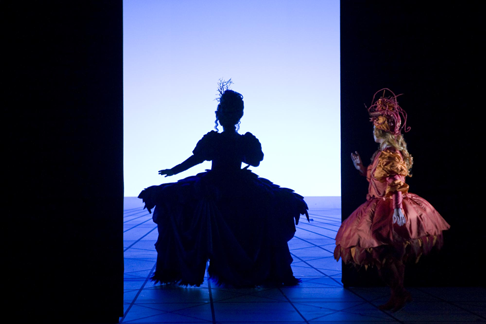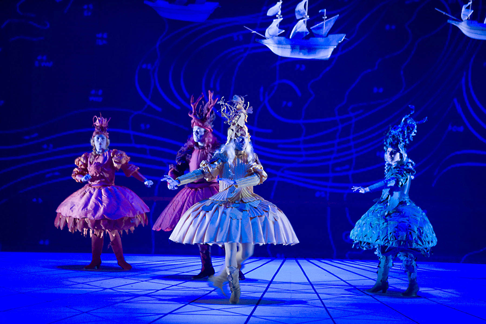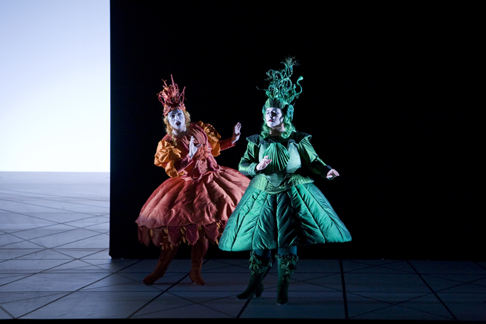01 Feb 2009
Partenope in Ferrara
The Greek princes Arsace (alto) and Armindo (alto) are seeking handsome Queen Partenope (soprano), who has just founded the city of Naples, in marriage.

The Greek princes Arsace (alto) and Armindo (alto) are seeking handsome Queen Partenope (soprano), who has just founded the city of Naples, in marriage.
Partenope is attracted to Arsace, without knowing that he has previously abandoned Rosmira, who now — disguised as a chieftain under the fictional name of Eurimene from Armenia — arrives in Naples with the aim of winning him back. A third prince, Emilio from the nearby reign of Cumae (tenor), declares war on Partenope, offering marriage for peace. His attack, however, is easily rebuked by the joint forces of the queen and her lovers, so Emilio is detained at Partenope’s court as in a chivalrous prison camp of sorts. Rosmira/Eurimene secretly confronts Arsace demanding that he keep her true identity covered, then provokes him publicly in every possible manner. In the end, she challenges him to a duel in a court of honor, but must withdraw as he puts the condition that they fight stripped to the waist. Partenope decides to marry Armindo, orders that repentant Arsace be reunited to Rosmira and sends back Emilio to Cumae on friendly terms.
A bit too madcap by the average standard of early opera seria, Silvio Stampiglia’s libretto was written for Naples in 1699 and subsequently set by several composers. Rather than in outstanding literary or dramatic merit, the secret of its popularity may lie in the variety of situations and the panoply of stock affetti associated to them. One would like to call Partenope a Baroque sitcom, now and then on the verge of vaudeville. A radical admirer, none less than Edward J. Dent, affected to find in it something of a Shakespearean atmosphere, apparently referring to the bittersweet climate of The Twelfth Night rather than to the Bard’s tragedies or history plays. As recently argued by the British Handel scholar David Vickers: ‘The plot offers ample scope for emotional intensity, insightful characterization, wit, sexual innuendo, and profound despair’. This is probably what most appealed to Handel, who, after an abortive attempt in 1726, succeeded to present his own setting of Partenope to the London public in 1730. After two not-too-successful runs in that year at the King’s Theatre, and a nearly disastrous revival in 1737 at the Covent Garden, Partenope disappeared for two centuries. Modern revivals in German and English translations started at the Göttingen Handel Festival in 1935 and went forth, if very sparsely, until 1998, when the original Italian libretto resurfaced in Cooperstown, NY, and in New York City. The present staging at Ferrara — scheduled to circulate later in Modena, Naples and Montpellier, France — was, believe it or not, the opera’s Italian premiere ever.
To devout Handelians like myself (as opposed to sane folk who would object to sitting at the opera for three-and-a-half hours), the experience of hearing live an almost uncut score of the Harmonious Blacksmith is increasingly rare and a potential source of delight. It did not happen this time. In addition to its unusually high number of arias, Partenope has a remarkably prominent number of ensembles (eight, including two choruses), two accompanied recitatives and some flamboyant instrumental music of a warlike character. Ottavio Dantone’s performing version, essentially based on Handel’s first version of three, pruned 8 out of 48 set pieces: four arias for Arsace, as many for Partenope, and one for Armindo — which seems a generous appeasement with modern listening habits.
 Elena Monti as Partenope, Sonia Prina as Rosmira
Elena Monti as Partenope, Sonia Prina as Rosmira
Nevertheless, there was still much left to cherish. First of all, a classy ensemble of voices, all well versed in period performing practice. A trio of ladies shared the best applause: as the de-facto protagonist Arsace, Marina De Liso sketched an enigmatic and irresolute anti-hero; nonetheless, her cleanly secure intonation, refined uttering and elegant coloratura were glorious throughout. As Rosmira/Eurimene, Sonia Prina towered as the relentless powerhouse she usually is onstage, sparking a regular ovation in her defiant aria ‘Io seguo sol fiero’ with obbligato horns and oboes. Valentina Varriale, as the moonstruck Armindo who finally gets the girl, impressed for the sheer beauty of her color, dark and fully fleshed-out. The quiet lilt of her heart-rending andante ‘Non chiedo, o luci vaghe’ conveyed all the elegy of selfless love, quite Arcadian-style.
 Sonia Prina as Rosmira, Gianpiero Ruggeri as Ormonte,
Cyril Auvity as Emilio, Marina De Liso as Arsace
Sonia Prina as Rosmira, Gianpiero Ruggeri as Ormonte,
Cyril Auvity as Emilio, Marina De Liso as Arsace
In the title role, Elena Monti embodied the seductive, authoritative and slightly vindictive nature of her character almost to perfection. Depriving her of her signature aria ‘Qual farfalletta’, towards the end of Act II, was indeed insensitive. Both Emilio and Partenope’s chamberlain Ormonte (bass) are deadpan roles, yet their respective performers Cyril Auvity and Gianpiero Ruggeri came out egregiously for their assured technique, also showing a firm grip of style requirements. In the remote confrontation with the role-creator Annibale Fabri (a virtuoso from Bologna who managed to become a lone tenor star in the age of castrati), Auvity had to struggle hard with a terrific range and treacherous coloratura. He emerged unscathed, albeit switching to a peculiar mixed utterance at the upper and lower ends of his tessitura. Who knows whether Fabri, described by a contemporary British observer as ‘a very good master of musick’ did the same?
 Sonia Prina as Rosmira, Valentina Varriale as Armindo
Sonia Prina as Rosmira, Valentina Varriale as Armindo
Giuseppe Frigeni’s integrated light-set-direction design and Regina Martino’s costumes provided a lesson of how to approach early opera without either irreverent gimmicks or cheap archaeological historicism. Their easily recognizable color codes, applied to studies in abstract perspective resembling chessboards, their luxuriant headpieces and peacock-shaped gowns for everybody (whether males, females or cross-dressers), conveyed a quintessential Spirit of Baroque — somewhat near to the Beijing Opera, where a single flag stands for ten thousand warriors or a model ship for whole fleets. Body language and perusal of stage space did fit admirably into the frame.
Antonio Florio and his (Naples-based) Pietà dei Turchini were slated to steer this important production. In the end, they declined because of budget disagreements, so the baton passed onto Dantone, whose period band Accademia Bizantina can stand on equal footing with any such ensemble in Italy. Indeed, they brought the wondrous machine to triumph and were awarded full honors; only a few skipped notes in the natural brasses gave evidence of limited rehearsing time, but this may improve later in the tour.
Carlo Vitali